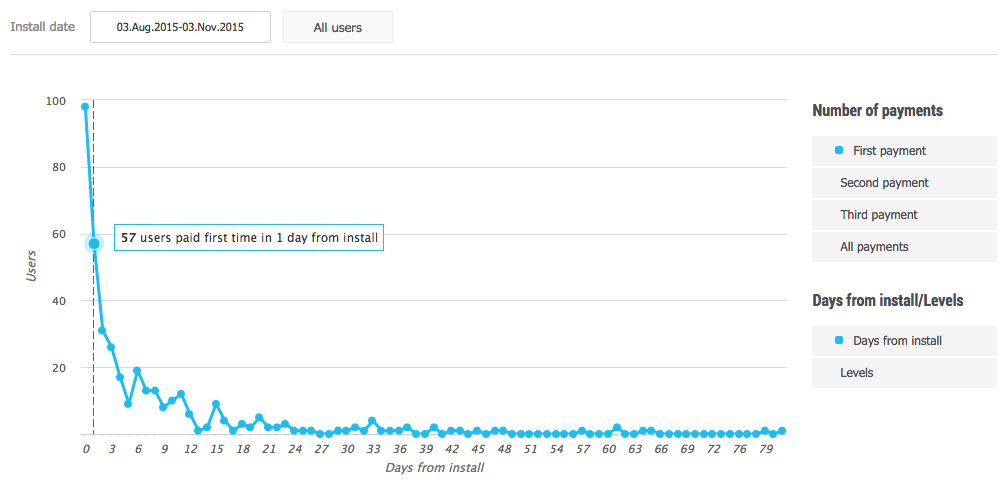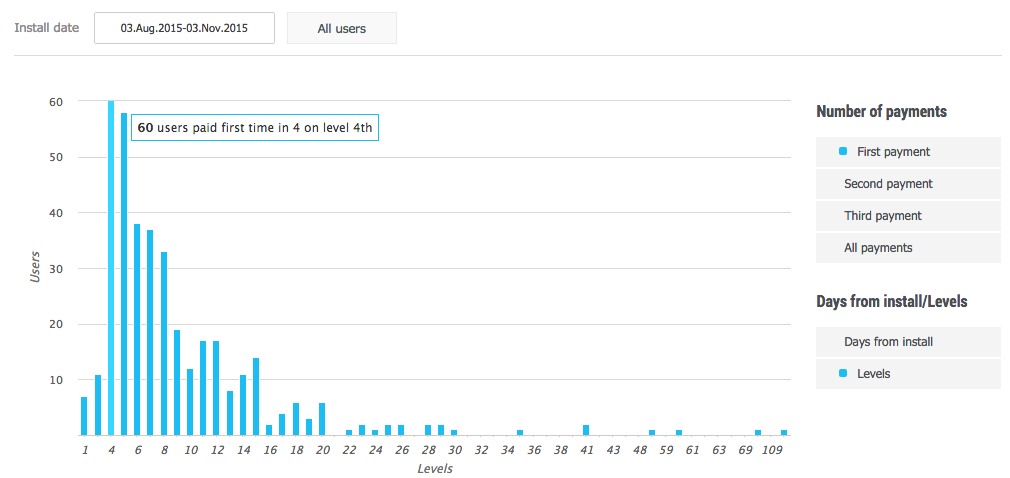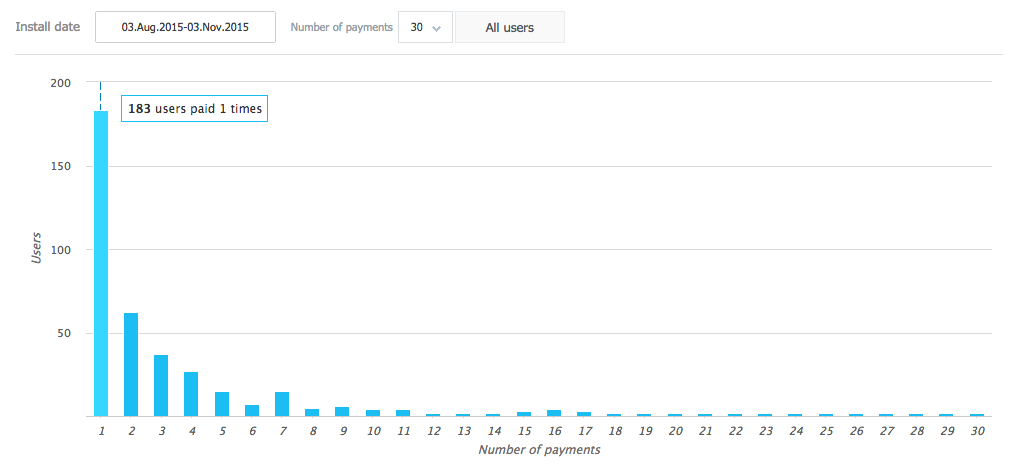How to analyze paying users. Part 3, Recurring Payments and Conversion
With this article we end the cycle "How to analyze paying."
Previous articles:
Part 1. RFM-analysis, whales and dolphins.
Part 2. The structure of income by time.
Today we will talk about repayments and time of conversion into payment. What questions should you ask yourself?
On what day does the user make the first payment? Second? Third?
Understanding the user's payment behavior will allow you to better plan monetization actions in your product. This application is traditional for product analytics algorithm:
Knowing when the user makes a regular payment, you will be able to get ahead of him and offer the right action (or targeted offer) at the right time.
For example, use the report 'Period until payments' analytical system devtodev . We choose the time of making the first payment on the right (you can also choose the second, third user payments, or all payments, regardless of their sequence number), set the user registration period and look at the distribution of the time they made their first payment.

We see that the main part of the first payments is made in the first days. Moreover, on the day of user registration. This means that we can safely offer any action from the very beginning of the user's stay in the application, from the first day.
However, to offer to buy something, for example, immediately after the passage of the tutorial, it would not be very correct - the user decides that the game is based only on donate and, quite likely, will immediately leave the application. Therefore, we ask the following question.
')
At what level does the user make the first purchase? And the second? And the third?
Again, we turn to the report 'Period until payments' and choose the distribution not by day, but by levels.

Aha Here is the peak, on the fourth and fifth levels.
Thus, we have identified a pattern - paying users mostly make the first purchase on the day of registration upon reaching 4-5 levels.
In the future, we will be able to embed a targeted offer corresponding to this pattern into the product (whether it be a game or, say, a training service). And this will help us increase the conversion to the payer on the first day.
How many users make one payment? How many users go to recurring payments? How are the amounts distributed by first and repeated payments?
Let's start with a little advice.
Tip : along with the Paying Users (the number of paying) and Paying Share (the share of paying users in the active audience), select the New Paying Users metric, which describes the number of users who made their first payment during the analyzed period. Without the first payment will not be repeated.
Speaking of the importance of repayments. The company Tapjoy analyzed applications that have earned a million dollars, and revealed several common signs.
The first sign : 84% of applications in which at least 1000 users made at least three payments in the first 90 days from the moment of the first entry, broke the $ 1 million barrier.
So that you can better understand the distribution of paying users by the number of payments made by them, we in devtodev developed the “Users by transactions” report. It allows you to see how many users have completed one transaction, two, and so on.

The second sign revealed by Tapjoy:
If at least 35% of the users who made the first payment, then make the second and third payments, then the application is likely to earn a million dollars.
The first payment is usually small in size. This can be seen in the example of the “Paying users activity” report:

The users making their first payment just want to test the advantage of paying for your product and are not ready to spend large amounts right away. In addition, the first payment is also a reason to tie the card to your account, if it was not attached earlier.
The main money supply is contained in repetitive payments.
Thus, in order to have financial success, your product must meet the following conditions:
On this cycle of articles on the analysis of paying completed.
Analyze the behavior of those who pay you, understand where your money comes from, and increase your cash flow.
Previous articles:
Part 1. RFM-analysis, whales and dolphins.
Part 2. The structure of income by time.
Today we will talk about repayments and time of conversion into payment. What questions should you ask yourself?
On what day does the user make the first payment? Second? Third?
Understanding the user's payment behavior will allow you to better plan monetization actions in your product. This application is traditional for product analytics algorithm:
- Identify the pattern in user behavior;
- We find users whose behavior at first corresponds to this pattern;
- We suggest these users to perform the next action from the pattern. For you, this looks like a logical continuation of the pattern, and for the user - as a targeted proposal at the most appropriate time.
Knowing when the user makes a regular payment, you will be able to get ahead of him and offer the right action (or targeted offer) at the right time.
For example, use the report 'Period until payments' analytical system devtodev . We choose the time of making the first payment on the right (you can also choose the second, third user payments, or all payments, regardless of their sequence number), set the user registration period and look at the distribution of the time they made their first payment.

We see that the main part of the first payments is made in the first days. Moreover, on the day of user registration. This means that we can safely offer any action from the very beginning of the user's stay in the application, from the first day.
However, to offer to buy something, for example, immediately after the passage of the tutorial, it would not be very correct - the user decides that the game is based only on donate and, quite likely, will immediately leave the application. Therefore, we ask the following question.
')
At what level does the user make the first purchase? And the second? And the third?
Again, we turn to the report 'Period until payments' and choose the distribution not by day, but by levels.

Aha Here is the peak, on the fourth and fifth levels.
Thus, we have identified a pattern - paying users mostly make the first purchase on the day of registration upon reaching 4-5 levels.
In the future, we will be able to embed a targeted offer corresponding to this pattern into the product (whether it be a game or, say, a training service). And this will help us increase the conversion to the payer on the first day.
How many users make one payment? How many users go to recurring payments? How are the amounts distributed by first and repeated payments?
Let's start with a little advice.
Tip : along with the Paying Users (the number of paying) and Paying Share (the share of paying users in the active audience), select the New Paying Users metric, which describes the number of users who made their first payment during the analyzed period. Without the first payment will not be repeated.
Speaking of the importance of repayments. The company Tapjoy analyzed applications that have earned a million dollars, and revealed several common signs.
The first sign : 84% of applications in which at least 1000 users made at least three payments in the first 90 days from the moment of the first entry, broke the $ 1 million barrier.
So that you can better understand the distribution of paying users by the number of payments made by them, we in devtodev developed the “Users by transactions” report. It allows you to see how many users have completed one transaction, two, and so on.

The second sign revealed by Tapjoy:
If at least 35% of the users who made the first payment, then make the second and third payments, then the application is likely to earn a million dollars.
The first payment is usually small in size. This can be seen in the example of the “Paying users activity” report:

The users making their first payment just want to test the advantage of paying for your product and are not ready to spend large amounts right away. In addition, the first payment is also a reason to tie the card to your account, if it was not attached earlier.
The main money supply is contained in repetitive payments.
Thus, in order to have financial success, your product must meet the following conditions:
- The user should come to the first payment himself, however you can help him by identifying the pattern and making an offer at the most opportune moment.
- Do not require a large first payment from the user. The first payment is usually small in size.
- The user should feel a return on investment, then he will be satisfied with the first purchase and will want to pay more.
- Your product should allow the user to pay as much as he wants. Each user, whether it is a non-paying or whale (user with the highest check), should enjoy using your product.
- Long-term retention is the key to good monetization. If the user is non-paying, the longer he is with you, the higher the likelihood of making a payment. If the user pays, then the longer he is with you, the more he can pay you.
On this cycle of articles on the analysis of paying completed.
Analyze the behavior of those who pay you, understand where your money comes from, and increase your cash flow.
Source: https://habr.com/ru/post/296022/
All Articles